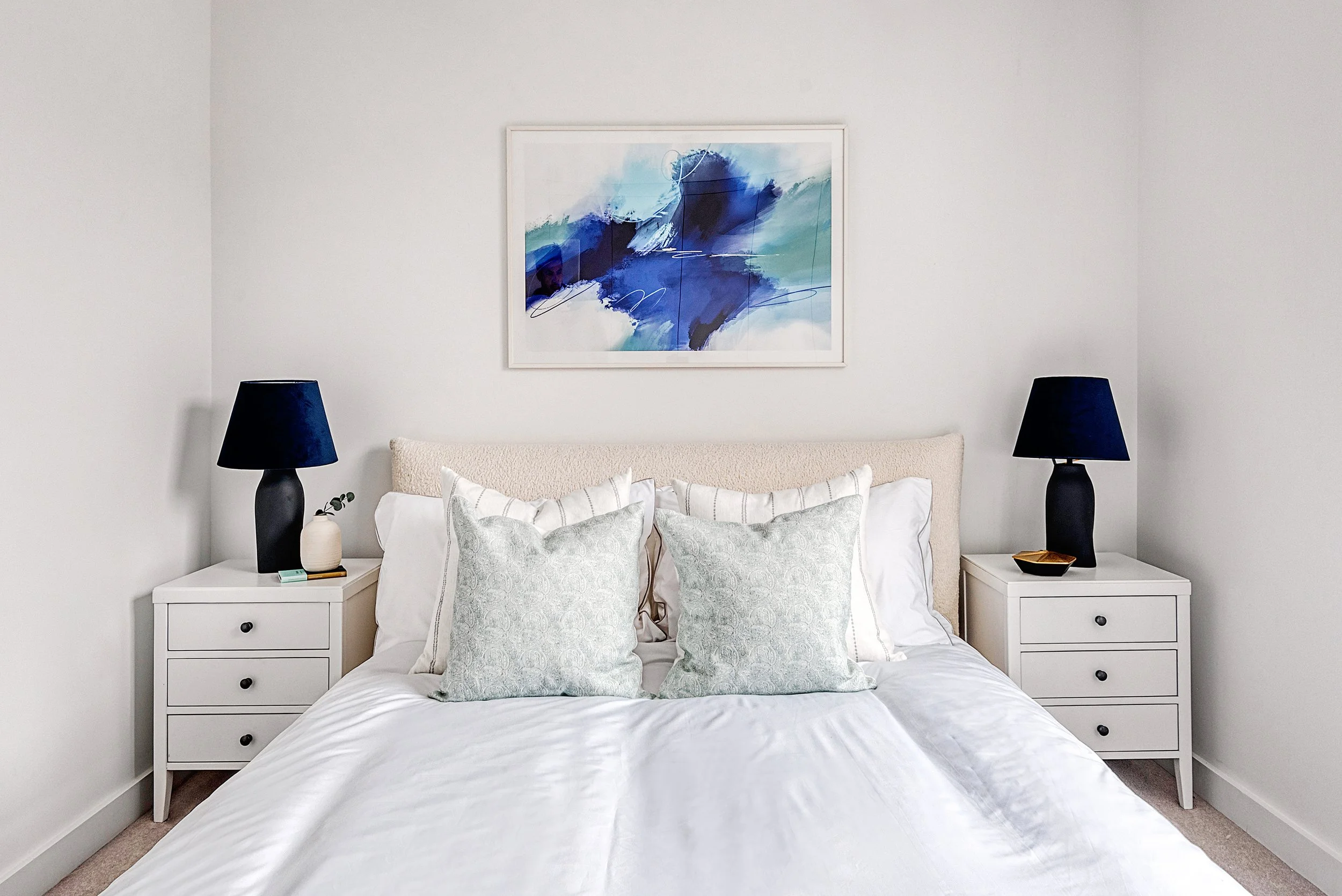In the spotlight: Denise Iordache
Image via Denise Iordache
In honour of Sleep Awareness Week, for this month’s blog we spoke to Denise Iordache, a cognitive behavioural hypnotherapist. As someone who has always had trouble sleeping, I felt like I had tried it all from creating a peaceful bedroom to a strict routine and meditation, but nothing ever seemed to work. It wasn’t until I got chatting to Denise at an event, that I realised there were so many more techniques I could try. Several of which were linked to a well-designed home, so she kindly agreed to share them with us today. The changing location in the night tip was the turning point for me!
Thank you so much for joining us, Denise. Tell us a little about your experience; how did you get into therapy, and why did you choose to specialise in insomnia?
After 15 years working in marketing and advertising, I began to find myself not feeling as passionate about it as I used to be. During this time I was actually seeing a hypnotherapist myself, and the more I learnt about the subject, things like the mind-body connection, how your thoughts influence your actions and how your emotions are sometimes triggers, I thought ooh there could be something in this for me. When the first lockdown came, I felt like everything became clearer and I realised my mission in life was starting to change. Shortly after I was made redundant from my marketing role at the time, so it felt like the planets were aligning and I decided to retrain as a cognitive behavioural hypnotherapist, specialising in sleep disorders (primarily insomnia), mindful weight management, habits, and phobias. My focus is on offering evidence and problem-based solutions to my clients that can help with a problem they are facing now, almost like a map to improvement.
So as today we are going to talk about how we can improve our sleep hygiene through design. What led you to select insomnia as one of your areas of focus?
I felt like there were so many people around me that are currently or have battled with insomnia at one point in their lives and I saw the impact that was having on their day-to-day life. Over time our bodies begin to struggle as the cells aren’t getting the restful sleep they need to renew. I was finding that people seemed to believe it is something that happens to them, that perhaps they are just unlucky, or it is a personality trait that they were born with. But I was learning that’s not the case. It has nothing to do with your personality. In many cases it is a symptom of something else.
To explain it very simplistically, I liken it to the game whack-a-mole, as when there is something wrong, your body or mind can send different signals to let you know. Insomnia can be one of those signals, or moles. Often, it’s your mind’s way of saying ‘hello, I’m awake, I’m worrying about something.’ If over time, you learn to live with the lack of sleep, or poor sleep, then your body and mind will find another way to tell you there is something wrong or the insomnia will become a cause in itself, leading to a vicious cycle. The effects of insomnia or poor sleep can manifest in a whole range of ways from mood swings to lack of concentration, increased levels of stress, ultimately leading to someone having less joy in their lives. This is where I hoped I would be able to help people and ultimately bring more moments of joy to their lives, hence why my company is named JoySpace.
(I must highlight, there are many causes for insomnia, and in some cases, it can also be triggered by medication or other underlining health concerns, so it is always worth speaking with your GP if you have regular sleep issues.)
“To explain it very simplistically, I liken it to the game whack-a-mole, as when there is something wrong, your body or mind can send different signals to let you know. Insomnia can be one of those signals, or moles.”
Starting your journey to improved sleep can be a daunting time, so how would you advise someone to get started?
I would advise you to start with a ‘thought form’ to help you start noticing what it is that is causing you to have trouble sleeping. This can be on a piece of paper or digitally on your phone notes, so as soon as you wake up in the night, note down what it is you are thinking about, which emotions you feel and what bodily sensations are present. From here you would start to have an understanding of what you might be dealing with and how you can work to improve it. If it’s an outstanding task that is keeping you up at night, then just go and do it! There is no point lying there awake for hours thinking you have not sent that email for example – so, get up, type it and save it in drafts to send in the morning.
The next step would be thinking about your sleep routine, and this ties into the way our homes are designed and how important lighting is.
So, what are the most important things to consider when designing our homes to support good sleep hygiene?
Let’s start with creating a good sleep routine. This is all about finding out how you relax and ensuring you create a sanctuary for you to do this in. Perhaps you love to end your day reading in a bubble bath, if so, then designing your bathroom to incorporate a bath with a shelf for your book and candles would be important. Or maybe you enjoy meditation, so you should think about designating a quiet corner of your home for this.
After your relaxing activity, it is important to go to the place you sleep to unwind, so if you sleep in your bed, go there next. That way you are making an attachment in your brain that this is where I unwind and therefore sleep. It seems obvious but ensure you have a comfortable bed and mattress. (VJS tip: Mattresses should generally be replaced every 6-8 years.)
When selecting bedroom furniture, consider what you will need it for, so if you like to read ensure you have a bedside table lamp. If you like to keep a paper thought form, ensure you choose a bedside table with an adequate amount of storage. Think about the materials you are choosing. I have never understood metal bedside tables or those incorporating glass tops, they make so much noise every time you touch them; this must be a nightmare when you reach for your water glass at night!
Once you have decided, you must stick to the timings and routine in order to realise the benefits.
“The last resort I recommend is in effect, having a ‘naughty chair’. This is an uncomfortable space you can go to”
If you can’t sleep, change location, perhaps it’s your guest bedroom or sofa, anywhere as long as it is somewhere comfy for you to sleep. If you are someone who regularly needs to do this, then factor this in when you are selecting furniture. Maybe a larger, deeper sofa in a dark durable fabric will be more practical than a dainty white linen sofa. If you have a spare bedroom, then it could be worth selecting a sofa bed that can be left open in the space ready for you to hop straight into.
If this doesn’t work, then the last resort I recommend is in effect, having a ‘naughty chair’. This is an uncomfortable space you can go to, maybe a chair or a spot on the floor. It sounds counterintuitive but although your mind may be alert, your body is tired, so if it remains somewhere comfortable your body feels relaxed, enabling the mind to keep racing. If you are somewhere uncomfortable then your body will be unable to relax, and your thoughts will be replaced with wanting to change location.
Finally, think about layering your lighting. When you turn on a bright light, you signal to your brain, ping we are awake, so having the ability to move around the house with minimal light is important to help you fall back to sleep as quickly as possible. You can do this by having separate switches that enable you the option of only turning on low level lighting, just enough to help you guide around the space instead of all the lights turning on at once. This is particularly effective in the bathroom or hallway. Another alternative is using dimmer switches.
The Quick Five
We are asking all of our guests 5 quick-fire questions in this series, so are you ready?
1. What is your earliest memory of design?
For me it was a dress design, I was very tiny, maybe only 2 or 3 but I remember it clearly. The dress was yellow with little embroidered red, blue, and green details. I can’t remember the shapes, but I remember the colours. I love yellow to this day!
2. What room or item in your home do you love the most, and why?
The bathroom! It’s the place I unwind after a long day. It’s the moment I go ahh and let go of whatever has happened throughout the day. That’s the feeling I try and help my clients bring into their routine before they get ready for bed.
3. One thing you believe can elevate or transform any room?
Details! You can have the most clinical white walls and minimalist furniture but if the details are on point, I think you can make it work. Layering textures and bringing in a splash of colour through the cushions or artwork makes it feel homely to me.
4. Best or worst design decisions you’ve made?
Glass topped bedside tables. Bad choice! They were so noisy every time I picked up my glass of water in the night.
5. What is the most recent item you’ve purchase for your home?
I got a little bit OTT with candles and diffusers recently. I just love them for creating a relaxing space.




